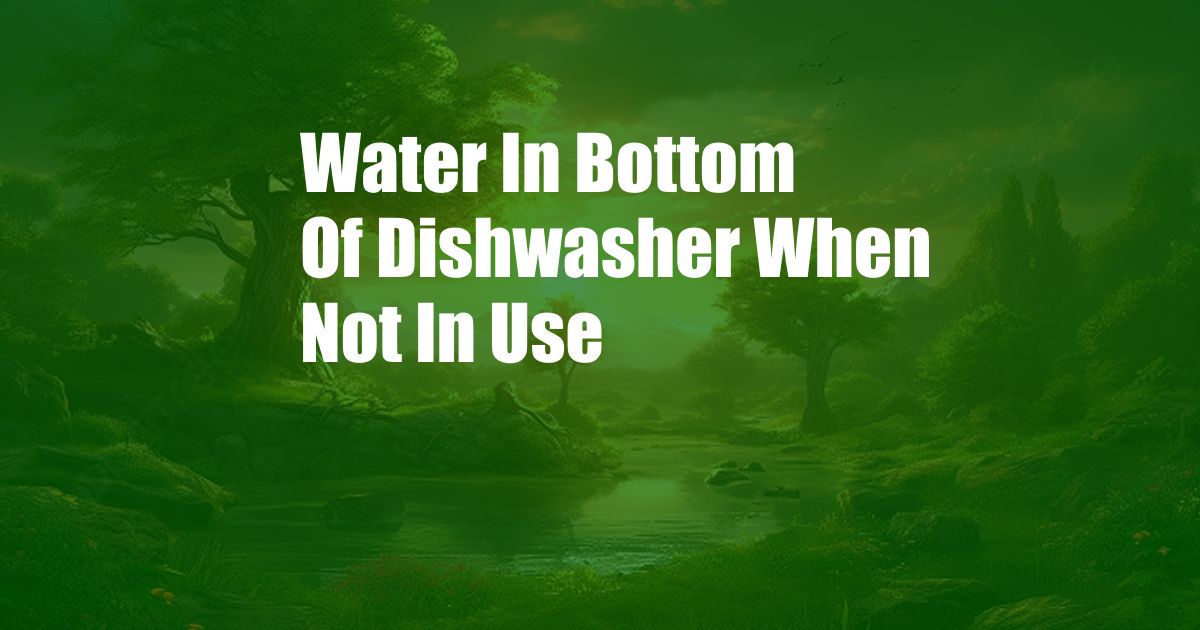
Water in the Bottom of Dishwasher When Not in Use: A Comprehensive Guide
In the realm of household appliances, dishwashers have emerged as indispensable companions, bringing convenience and saving us precious time. However, even these modern marvels can occasionally pose puzzles, such as the perplexing issue of water accumulating in the bottom when the dishwasher is not in use.
Finding a pool of water in your dishwasher can be alarming, prompting concerns about leaks or malfunctioning components. Fret not, as this article will unravel the mystery behind this phenomenon and equip you with actionable solutions to restore your dishwasher to its pristine state.
Reasons for Water in the Bottom of Dishwasher When Not in Use
Condensation Buildup
One potential culprit is condensation. As hot, moist air from the dishwasher’s last wash cycle cools, it condenses into water droplets that collect at the bottom of the dishwasher.
This is particularly common in humid environments or when the dishwasher is closed immediately after a wash cycle. Leaving the dishwasher door slightly ajar allows the moisture to escape, preventing condensation from accumulating.
Faulty Door Latch
Another possibility is a faulty door latch. A properly functioning latch forms a watertight seal, preventing water from leaking out during a wash cycle. However, if the latch is damaged or misaligned, water can seep out and pool at the bottom of the dishwasher.
Inspect the door latch for any visible damage or wear. If the latch appears faulty, it may require replacement to resolve the issue.
Clogged Drain Hose
The drain hose is responsible for draining water out of the dishwasher after each wash cycle. If the drain hose becomes clogged or kinked, water can back up and accumulate at the bottom of the dishwasher.
Clear the drain hose of any obstructions or kinks to ensure proper drainage.
Valve Malfunction
The dishwasher’s water inlet valve controls the flow of water into the appliance. A faulty valve can malfunction and allow a continuous trickle of water to enter the dishwasher, even when it is not in use.
If you suspect a valve malfunction, contact a qualified appliance technician for diagnosis and repair.
Overflow Float Switch Malfunction
The overflow float switch prevents the dishwasher from overflowing by automatically shutting off the water supply when the water level reaches a certain height. If the float switch malfunctions, it may not activate properly, allowing water to overfill and accumulate at the bottom of the dishwasher.
Replace the overflow float switch if it is suspected to be malfunctioning.
Tips and Expert Advice for Preventing Water in the Bottom of Dishwasher
Regular Dishwasher Maintenance
Regular maintenance is key to keeping dishwashers in optimal condition. Clean the dishwasher’s filter regularly to remove food particles and debris that can clog the drain hose or interfere with the valve’s operation.
Proper Dishwasher Etiquette
Avoid overloading the dishwasher or using the wrong type of detergent. Overloading can cause dishes to block the spray arms, preventing thorough cleaning and creating an environment conducive to condensation buildup. Using the right amount of detergent specifically formulated for dishwashers helps prevent suds and residue buildup that can clog the drain hose.
Leave Dishwasher Door Ajar
Leaving the dishwasher door slightly ajar after a wash cycle allows moisture to escape, reducing condensation buildup and preventing water from pooling at the bottom.
Contact a Qualified Technician
If you are unable to resolve the issue самостоятельно or suspect a more complex problem, do not hesitate to contact a qualified appliance technician. They can diagnose and repair any underlying issues, ensuring the safe and efficient operation of your dishwasher.
FAQ on Water in the Bottom of Dishwasher When Not in Use
Q: Is it normal to have some water in the bottom of the dishwasher?
Yes, it is normal to have a small amount of water (less than 1/4 inch) in the bottom of the dishwasher after a wash cycle. This residual water helps keep the dishwasher’s seals moist and prevents leaks.
Q: What should I do if there is a lot of water in the bottom of my dishwasher?
If you find a large amount of water in the bottom of your dishwasher, follow the steps outlined in this article to identify the cause and implement a solution. Check for condensation buildup, a faulty door latch, a clogged drain hose, a faulty valve, or an overflow float switch malfunction.
Q: How can I prevent water from accumulating in the bottom of my dishwasher?
Regular dishwasher maintenance, proper dishwasher etiquette, and leaving the dishwasher door slightly ajar after a wash cycle can help prevent water buildup in the bottom of the dishwasher.
Conclusion
Water in the bottom of a dishwasher when not in use can be a cause for concern but is typically not a sign of a major issue. By following the tips and insights provided in this article, you can effectively address the problem and restore your dishwasher to its intended function.
Remember, addressing these issues promptly can extend the lifespan of your dishwasher and ensure a clean and efficient dishwashing experience for years to come. Are you experiencing any of the issues discussed in this article? Share your questions or insights in the comments below, and let’s explore solutions together.